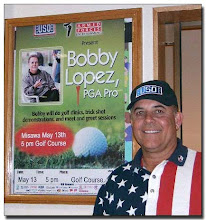Is the Golf Grip Really That Important?
Boy have I been running into some rotten grips lately! I've seen better grips on a Miller Lite!
The most important function of the grip is controlling club face angle. As you now know, this angle is a primary influence on ball flight. Also, the way you hold and control the club face position influences your overall swing motion.
You probably have seen illustrations of the Vardon grip, the most common modern golf grip. You may have focused on the overlapping pinkie as the most significant aspect of the grip. You would naturally assume that if you placed your hands and fingers in this approximate position, you would have a proper grip. You might have missed the most significant point: the positioning of the hands in relation to the club face angle. This relationship has surprising influence on your swing and, more importantly, on your ball flight.
Most golf books will tell you that the back of your left hand should be facing the target, yet I find that most tour players or good amateurs play from what is called a “stronger” grip position. The back of your left hand should be facing about 10 o’clock and the palm of your left hand at 4 o’clock. The club runs at an angle from the fleshy pad of the hand to the point where it runs across the top joint of the forefinger. As your left hand closes on the club, you should be able to see the knuckles of the forefinger and middle finger as you look straight down on the club. The thumb runs down at about 2 o’clock on the grip and the “V” formed by your thumb and hand will point somewhere between your right ear and right shoulder. Please refer to the illustrations for samples.
If the left hand is turned excessively in a clockwise direction, so the back of your hand points skyward or to the right of the target line, you have too “strong” a grip. The opposite is true for too “weak” a grip.
With the left hand in good position, the right hand should fall in a naturally opposing position, so the palm of the right hand is pointed at about 10 o’clock. The “lifeline” of the lower hand fits over the thumb of the upper hand. The “V” formed by the thumb and hand should also point somewhere between the right ear and the right shoulder. With both hands in this position, you have a “neutral headed toward strong” grip. Professionals have had more success leaning toward a strong grip rather than a weak one.
Here's a video that might help you with your grip
Labels: Golf Grip


0 Comments:
Post a Comment
<< Home